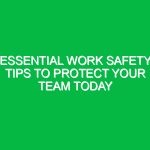Introduction
In the realm of construction and maintenance, the term “scaffold” plays a pivotal role. But what is a scaffold, and why is it significant in the Health, Safety, and Environment (HSE) domain? A scaffold is a temporary structure that supports workers and materials during the construction, maintenance, or repair of buildings and other large structures. It is essential for providing safe access and facilitating work at height, thereby minimizing risks associated with falls and other workplace hazards.
Scaffolds are not merely functional; they are integral to ensuring compliance with safety regulations and promoting an environmentally responsible approach in construction practices. This guide seeks to explore the comprehensive aspects of what is a scaffold, its significance in HSE, the associated risks, best practices for safety, and the regulatory framework that governs its use.
Understanding Scaffolds
What is a Scaffold?
A scaffold is a temporary framework that supports workers and materials during construction or maintenance tasks performed at elevated heights. Typically made from metal (like steel or aluminum) or wood, scaffolds are designed to provide a stable platform from which workers can safely access hard-to-reach areas. The versatility of scaffolds allows them to be used in various construction activities, from residential homes to skyscrapers.
Types of Scaffolds
Several types of scaffolds are commonly used in the construction industry, each designed for specific applications:
- Supported Scaffolds: These are built from the ground up and supported by posts, frames, or outriggers. They are the most common type.
- Suspended Scaffolds: These are hung from the roof or other overhead structures and are often used for window cleaning or maintenance.
- Rolling Scaffolds: These are mobile scaffolds that can be moved horizontally. They are ideal for tasks that require frequent repositioning.
- Scaffold Platforms: These are flat surfaces that provide a stable area for workers to stand on while performing their tasks.
Understanding the different types of scaffolds is crucial for selecting the appropriate one for specific tasks while ensuring compliance with safety regulations.
Importance of Scaffolds in HSE
In the context of Health, Safety, and Environment (HSE), scaffolds are crucial for several reasons:
1. **Safety During Height Work:** Scaffolds provide a stable platform, reducing the risk of falls—a leading cause of workplace injuries and fatalities in construction.
2. **Improved Efficiency:** By offering safe access to elevated areas, scaffolds enhance worker productivity and efficiency, allowing for quicker project completion.
3. **Environmental Considerations:** Properly designed scaffolds can minimize the environmental impact of construction activities, ensuring that debris and materials do not harm the surrounding area.
Key Components and Best Practices for Scaffold Safety
To ensure that scaffolds serve their purpose safely, several key components and best practices must be adhered to:
Key Components of a Scaffold
Understanding the essential components of a scaffold is vital for ensuring its safe use. The primary components include:
- Standards: Vertical posts that support the structure.
- Ledgers: Horizontal supports connecting the standards.
- Braces: Diagonal supports that stabilize the scaffold.
- Platforms: The surfaces on which workers stand while performing tasks.
- Guardrails: Safety barriers that prevent falls from the edges of the platform.
Best Practices for Scaffold Safety
Implementing best practices is essential for maintaining scaffold safety. Here are several guidelines:
1. **Regular Inspections:** Conduct daily inspections to identify potential hazards such as loose components, corrosion, or structural instability.
2. **Training and Certification:** Ensure that all workers who use scaffolds are trained and certified in scaffold safety. This training should include understanding the load capacity, inspecting scaffolds, and recognizing hazards.
3. **Proper Assembly:** Follow manufacturer instructions for assembly and disassembly to ensure the scaffold is stable and secure.
4. **Use of Personal Protective Equipment (PPE):** Workers should wear appropriate PPE, including hard hats, harnesses, and non-slip footwear, to enhance safety while working on scaffolds.
5. **Load Management:** Be aware of the weight limits of scaffolds. Overloading can lead to structural failure, posing significant risks to workers.
Potential Hazards and Risks
While scaffolds provide essential support, they also present various hazards that can affect worker safety:
Common Hazards Associated with Scaffolds
1. **Falls:** The most prevalent risk associated with scaffold use. Falls can occur due to improper use, lack of guardrails, or unstable platforms.
2. **Collapses:** Scaffolds may collapse if not properly constructed or if overloaded, endangering workers and bystanders.
3. **Falling Objects:** Tools or materials can fall from scaffolds, posing risks to individuals below. Implementing toe boards and debris nets can help mitigate this risk.
4. **Electrical Hazards:** Scaffolds erected near power lines can present electrocution risks. Maintaining appropriate distances and employing lockout/tagout procedures are crucial.
Safety Considerations
To reduce the risks associated with scaffolds, consider the following safety measures:
– Ensure scaffolds are erected on stable ground and are level.
– Use safety nets or catch platforms to protect against falling objects.
– Maintain clear communication among workers, especially when working on or around scaffolds.
Regulations and Standards Governing Scaffolds
Adhering to regulations and standards is vital for scaffold safety. Various organizations provide guidelines that govern scaffold use:
Key Regulations and Standards
1. **Occupational Safety and Health Administration (OSHA):** In the United States, OSHA provides specific regulations regarding scaffold safety in construction (29 CFR 1926.451). These regulations cover scaffold design, assembly, and safety requirements.
2. **American National Standards Institute (ANSI):** ANSI standards offer guidelines on scaffold safety and performance, promoting best practices in scaffold design and construction.
3. **Local Regulations:** Many countries and local governments have additional regulations that may apply to scaffold use, emphasizing the importance of compliance with all applicable laws.
Understanding and complying with these regulations not only ensures worker safety but also protects organizations from legal liabilities.
Conclusion
The importance of scaffolds in the Health, Safety, and Environment (HSE) domain cannot be overstated. They are crucial for providing safe access to elevated work areas, enhancing efficiency, and promoting environmental stewardship. However, the inherent risks associated with scaffold use necessitate strict adherence to safety practices and regulatory compliance.
As construction practices evolve, it is vital to remain informed about best practices, new regulations, and safety innovations related to scaffolds. By prioritizing safety and environmental considerations, the construction industry can significantly reduce injuries and create a safer work environment for everyone involved.
Reflecting on the significance of what is a scaffold in HSE, it’s clear that a proactive approach to safety not only protects workers but also contributes to the overall success and sustainability of construction projects.


